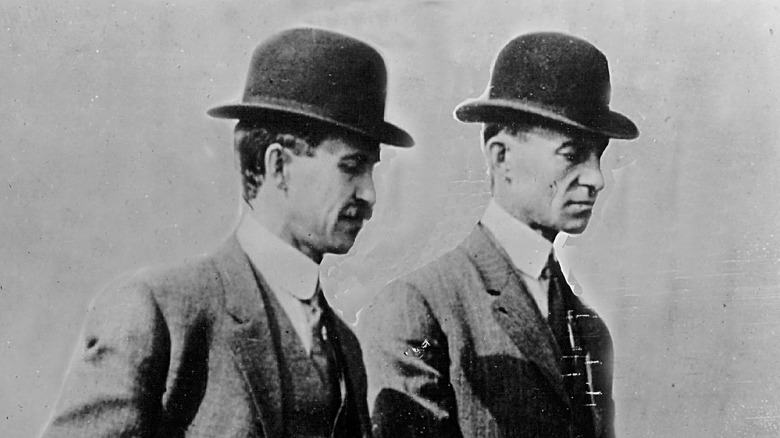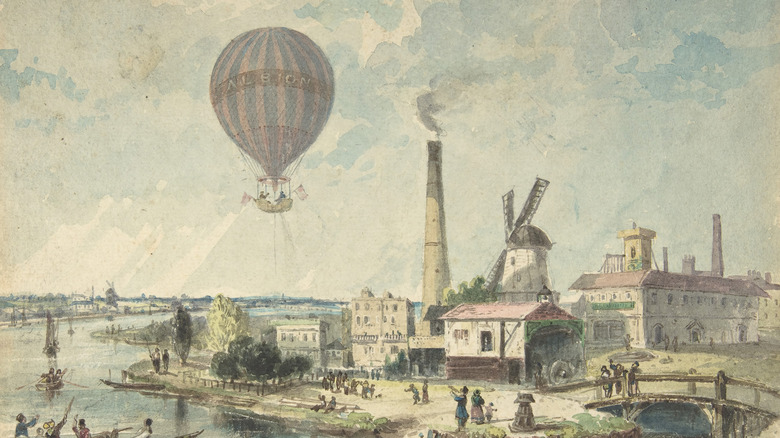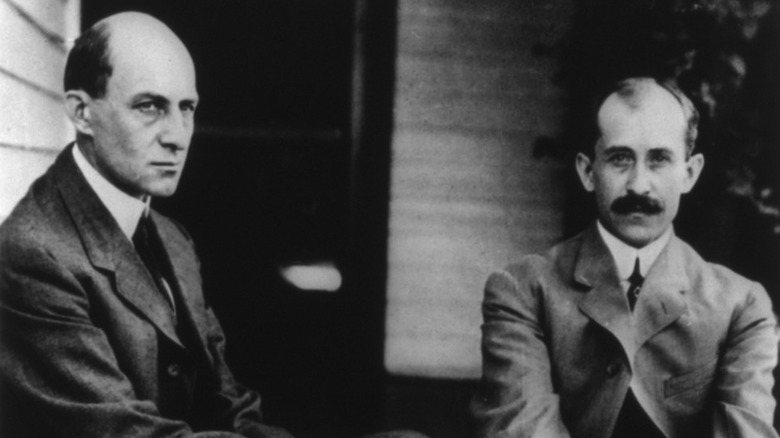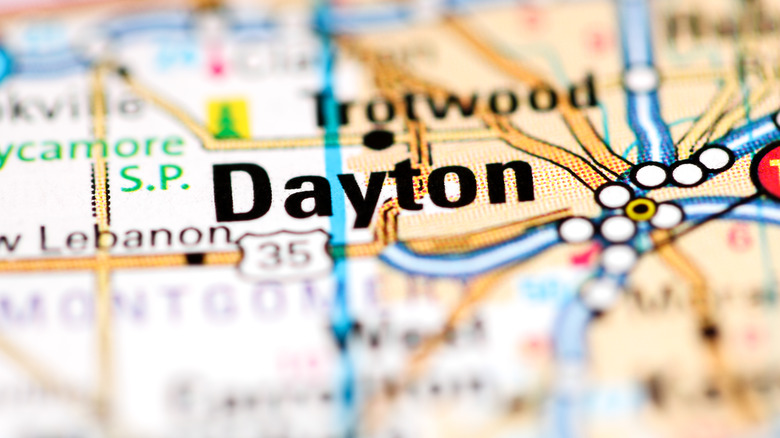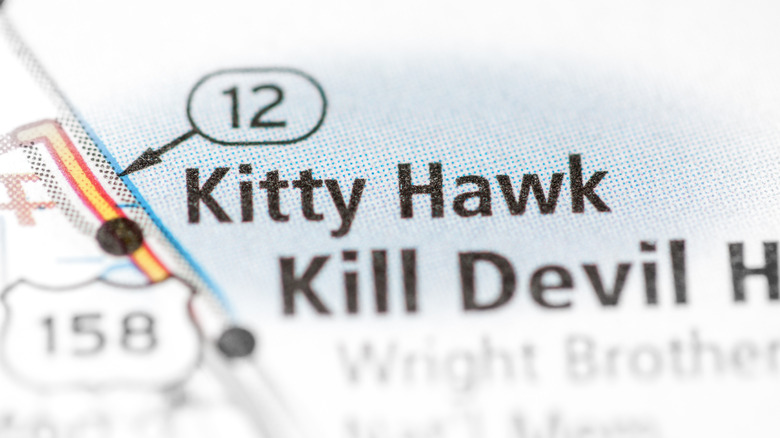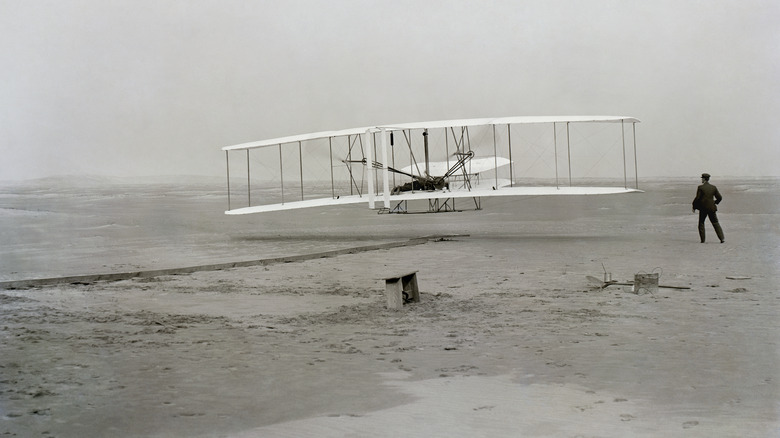The Feud Between Two States And The Wright Brothers' First Flight Explained
For the past few decades, the 50 states have been attempting what is, for lack of a better choice of words, branding. For example, you may have heard the phrase, "Virginia is for lovers," which was and is literally advertising copy written by an ad exec in the 1960s, according to a Virginia tourism website. Other states have leaned into state mottos, perhaps by putting them on their license plates. Missouri, for example, branded its license plates for a time with "Show-Me State," an unofficial/official motto of the state (that no one really knows the origin of or even what it means). Across the Mississippi River, Illinois leans into its "Land of Lincoln" heritage (Abraham Lincoln lived there for much of his life).
North Carolina and Ohio, for their parts, each consider their state to be the "First in Flight" for adjacent but different reasons (via WVXU). North Carolina makes the claim because the first powered flight of an aircraft took place there. However, the men who built the plane were born in Ohio and did most of their work there. So which state gets to make the claim?
In 2020, the two states called a truce of a sort, although it hardly put the matter to rest.
What Even Was The First Flight?
Putting aside the role the Wright brothers played in the development of flight, it bears noting that the phrase "First in Flight" has to apply only to the first powered flight — which is to say, an aircraft propelled by an engine. According to NASA, humans have been "flying" for centuries. We don't know the first person to attempt to build a flying contraption and then jump off of a cliff to see how it works, likely because they didn't live to write it down. We do know, however, that in 1783, two Frenchmen became the first passengers in a hot-air balloon (that is, and lived to tell about it).
More-or-less functional gliders came along in the next couple of centuries, and by 1891, Samuel Langley had built a steam-powered aircraft that actually managed to fly a few feet (without passengers). By 1894, a man named Octave Chanute had written a book that compiled everything that was known about flight at that time, and the Wright Brothers went on to use that book (with Chanute's occasional input) to develop their own flying machine.
The Wright Brothers
The Wright Brothers are two of those men that American schoolchildren learn about in the discussion of great American inventors, tinkerers, industrialists, and thinkers, like George Washington Carver or Thomas Edison. And of course, most Americans, when asked about them, are going to mention their flight. In fact, their contributions go deeper than just powered flight.
Their father was an important cleric, and as such, the family was encouraged to pursue intellectual pursuits, according to Britannica. This fondness for identifying problems and then solving them through innovation manifested in two of the pair's earlier inventions (or more accurately, improvements on existing inventions). When tasked with printing a newspaper, for example, the men improved and designed better printing machinery. Later, they made improvements to the bicycle (a new-ish invention at the time).
With the money they earned from their print shop and bicycle business, the men invested what they could into their plans to develop powered flight.
The Ohio Connection
The history books have recorded that the first powered human flight took place at Kitty Hawk, North Carolina (per Britannica); that much is beyond dispute. So why has Ohio been angling for a place in flight history? Because the Wright Brothers did most of the groundwork for that flight in the Buckeye State.
As a website dedicated to the brothers explains, during the lads' childhood and teen years, the family moved quite a bit around the Midwest, as their father's clerical duties took them here and there. By 1884, the family had moved to Dayton, Ohio, which is also the place where the brothers developed their printing and bicycle innovations. Though the first powered flight took place in North Carolina, there was a reason for that (more on that later). However, it was in Ohio where the brothers did almost all of the groundwork that led to their flight. In fact, they had mixed feelings about Kitty Hawk — they made friends there, but they were also bedeviled by mosquitoes and sand, prompting one brother to posit that it was what he expected the Sahara Desert to look like (via the National Air and Space Museum).
The North Carolina Connection
If the Wright brothers were living and working in Ohio and developing their flying machine there, then why on Earth did they make their first flight several hundred miles away, on an isolated stretch of beach in North Carolina? The answer is that, as the National Air and Space Museum explains, is that the North Carolina beach had what Ohio didn't: wide-open spaces devoid of trees (and people and animals) to crash into, favorable winds, and sand (which, theoretically anyway, is more forgiving to crash-land on than solid ground). "We came down here for wind and sand, and we have got them ... The sand is the greatest thing in Kitty Hawk, and soon will be the only thing," a seemingly-exasperated Orville wrote (per the National Air and Space Museum).
So desolate and sparsely populated was Kitty Hawk at the time that few people even showed up at the beach that day to watch history being made. One of the few surviving photographs from that day shows one of the flight's few witnesses — a young boy name Tom Tate who, by all appearances, seems to have been more concerned about catching a fish that day than witnessing history.
The Two States Reconcile, Kind Of
In 2020, North Carolina and Ohio buried the hatchet and decided to honor the Wright brothers jointly, with celebrations in each state honoring the anniversary of the brothers' groundbreaking flight (via WXVU). This was during the worst of the COVID-19 pandemic, so much of the hoopla was carried out online rather than in-person. Celebrations in both states included keynote speakers, wreath-laying, and flyovers, among other ceremonies. "The story of First Flight includes both Ohio and North Carolina. It wouldn't have been possible without both pieces of that puzzle," said Elizabeth Connor, director of communications with the National Aviation Heritage Area in Dayton.
Meanwhile, flight has improved exponentially since the Wright brothers' first flight. Within a couple of decades, flying machines were being used as weapons of war, and a couple of decades after that, passengers were paying for flights across the oceans. And a couple of decades later still, we were sending men into space and even putting them on the moon.
